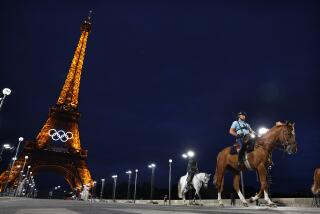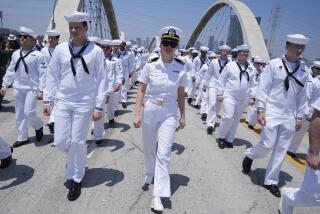Navy Ship Commissioning to Be Port of Hueneme’s 1st
ABOARD THE USS STETHEM — Standing at the ship’s rail in his Cracker Jack dress whites just after sunrise, Vic Rivera’s mind was awash with visions of the days ahead:
The pomp and pageantry of the formal commissioning of his ship into the U.S. Navy. Getting together with his fiancee and his best friend from Channel Islands High School. Throwing a barbecue for his shipmates at his mom’s house in Oxnard.
Rivera could not wait to flee Oxnard 11 years ago when he joined the Navy. Now that he has risen through the ranks and developed sturdy sea legs, he was pumped up to be coming home on the Navy’s newest, sleekest warship for his friends and family to see.
“I never figured I’d be coming back to Oxnard with the Navy,” said Rivera, a first-class petty officer who works as an electronic warfare technician. “It’s great to be home.”
With 1,500 Seabees standing at attention on the shore, the Aegis guided-missile destroyer glided gracefully into the Port of Hueneme early Tuesday morning to begin nearly a week of festivities that will culminate in the official commissioning on Saturday.
Once officially accepted into the Navy’s fleet of 374 ships, the Stethem (pronounced STEED-um) will be the first ship named after an enlisted man and the first ever to be commissioned at Ventura County’s deep-water port.
The Navy selected the Port Hueneme Seabee base because the ship is named after Petty Officer Robert Dean Stethem, a Seabee diver slain by terrorists during the hijacking of a TWA airliner to Beirut in 1985.
Stethem’s mother, Patricia, will present her son’s Bible to the ship as a gift. The rest of the family will attend the ceremony too.
“We never solicited this, “ said Dick Stethem, father of the fallen Seabee. “But it’s been a happy point in our lives since this happened to him.”
The Stethem will be based in San Diego, where the ship got underway Monday on the final leg of a long trip that began at Ingalls Shipbuilding in Pascagoula, Miss.
*
With three short blasts from the ship’s air horn, Navy tugboats helped ease the destroyer’s 8,600 tons from the San Diego dock and into position to navigate through the harbor.
The bridge buzzed with activity. The ship’s captain, Cmdr. Steven C. Miller, dashed between the main bridge and an open-air bridge wing to oversee a swarm of officers and enlisted men scouting the waters ahead to chart a path through the narrow shipping lane.
Sailboats and Boston whalers lazed in the ship’s path, blissfully unaware of what it takes to stop the 505-foot-long steel behemoth bearing down on them. The pleasure boats kept the sailors jumping, forcing them to slow, alter course or signal with warning blasts from the horn.
Reaching the mouth of the harbor, the captain gazed at the open sea.
“All engines ahead two-thirds,” Miller commanded. His order echoed down the ranks as sailors repeated the command and sprung into action.
“It’s great to be at sea again,” Miller said, taking a deep drag off a tiny cigar.
*
Four decks below, another team of sailors labored over another chart. They plotted the same course as their counterparts on the bridge, but based their heading on radar readings.
This group, toiling in a windowless room, checks its conclusions with the sailors topside.
The dimly lit room is the brain of the ship. It’s called the Combat Information Center and it’s where the captain would stand during battle. The room is filled with banks of computer screens and other displays of the coastline, oil rigs, islands--everything that floats, or flies.
Soon the 17-hour voyage settled into a routine. The captain ordered the ship to motor up the coast using only one of its four gas turbine engines, as a way to save diesel fuel. The Stethem moved at 10 knots an hour, about a third of its top speed.
As darkness settled, the crew on the bridge thinned out. Officers and technicians operated in near darkness, walking about with red-colored flashlights. The brightest light came from a conventional radar screen that showed the arm of radio waves sweeping the horizon for ships and shoals.
The idea is not to blind the officers and crewmen scanning the horizon.
*
Fresh crews cycled through on new watches every four or five hours. The Stethem continued to push up the coast through the night on minimum staff--until a boatswain’s pipe pierced the quiet by announcing reveille. The time was 5 a.m.
Within a half hour, the bridge was humming with activity again.
The captain and top officers squinted through binoculars to scan the lights twinkling along the Ventura County coast. They barked orders to help lay a graceful arching course that would lead straight through the breakwater into the Port of Hueneme.
Just after first light, the Stethem was greeted by two tugboats carrying a harbor pilot, some television crews and public officials.
One tug nestled up against the ship, so its passengers could scramble up a rope ladder and onto the destroyer. They wanted to ride the ship on the tail end of its historic voyage.
As the tugs led the Stethem into the harbor, many of the ship’s 300 enlisted men in dress whites stood at attention along the rails. They were greeted by Seabees clad in green camouflage fatigues lined up in formation.
Tugboats nudged the destroyer, as Navy seamen strained at the ship’s hefty lines, pulling the lines hand over hand to help jockey the ship into position.
“Slack the stern line,” Miller ordered, joining with the harbor pilot to choreograph the final docking.
“All stop. All stop,” the captain ordered.
His order was repeated down the chain of command until the ship stopped moving.
The Stethem had arrived.
More to Read
Sign up for Essential California
The most important California stories and recommendations in your inbox every morning.
You may occasionally receive promotional content from the Los Angeles Times.










